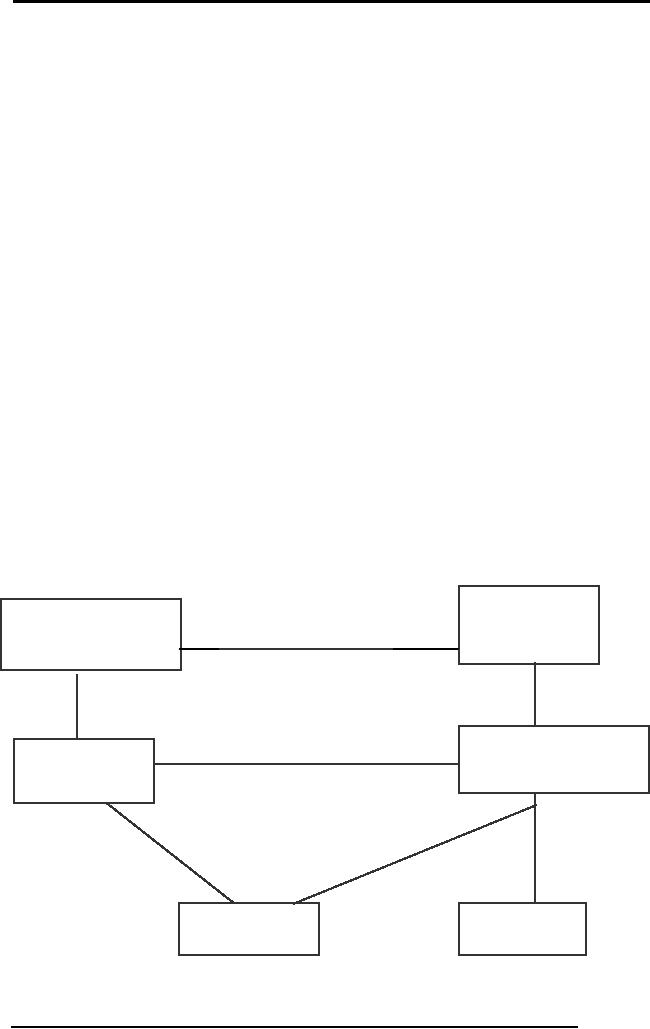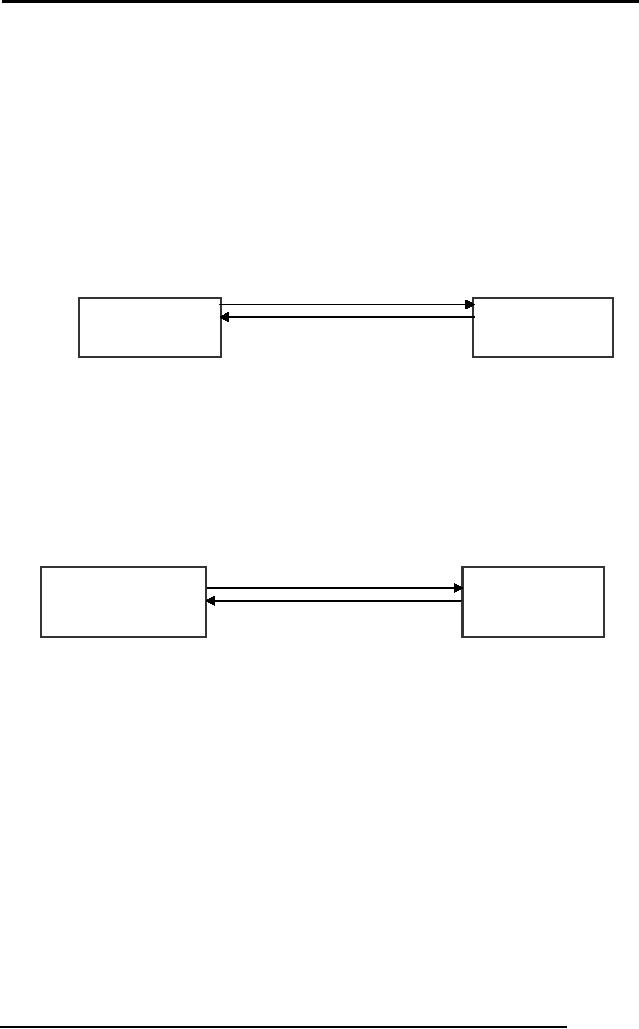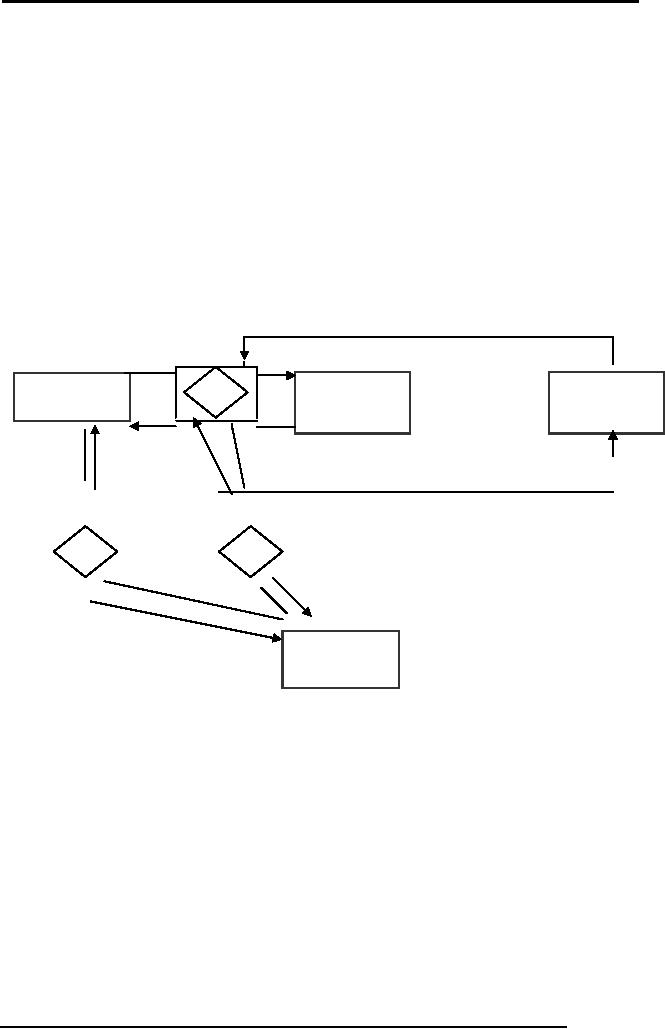 |
Conceptual, Logical Database Design, Relationships and Cardinalities in between Entities |
| << Steps in the Study of system |
| Relational Data Model, Mathematical Relations, Database Relations >> |

Database
Management System
(CS403)
VU
Lecture No.
13
Reading
Material
Case
Study
Overview of
Lecture
E R
Diagram of Examination System
o
Conceptual
Data Base Design
o
Relationships
and Cardinalities between
the entities
o
In the
previous lecture we discussed
the Preliminary phase of the
Examination
o
system.
We discussed the outputs
required from the system
and then we drew
the data
flow diagrams DFDs. From
this lecture we will start the
conceptual
model of
the system through E-R
Diagram.
Identification
of Entity Types of the
Examination System
We had
carried out a detailed
preliminary study of the
system, also drawn the
data
flow
diagrams and then identified
major entity types. Now we
will identify the
major
attributes
of the identities, then we will
draw the relationships and
cardinalities in
between
them and finally draw a
complete E-R Diagram of the
system.. So first of all
we will
see different attributes of
the entities.
Program:
This
entity means that what
different courses are being
offered by an institute,
like
MCS,
BCS etc. Following are the
major attributes of this
entity:-
o pr_Code.
It
can be used as a primary key
of the entity as it would
always be
unique
for example MBA, MCS,
etc.
o max_Dur
It
means that what is the
maximum duration of any
particular
course ,
like 1 year , 2 years and so
on.
o no_of_Semesters
How
many semesters this program
has like four ,six
and so
on.
o Pr_Lvl
This
course is of undergraduate, graduate or
post graduate level.
Student:
118

Database
Management System
(CS403)
VU
Following
are the major attributes of
this entity:-
o Reg_No
This
can be used as a primary key
for this entity as it will be
unique
for
every student.
o st_Name
This
would be the first name of
all the students of an
institute.
o St_Father_name
This
would represent the father's
name of a student.
o St_date_of_Birth.
The date
of birth of all students including
year , month
and
day.
o st_Phone_no
o st_GPA
This is a
very important attribute.
Now to know the GPA of
any
student,
we need to know the student
reg no and the particular
semester. So
this is a
multi valued attribute as to
know the GPA, different
attributes values
are
required. So this represented by a
relation, which will be discussed in
the
relationships
in between entities.
o st_Subj_Detail
This is
also a multi valued
attribute ,as to know the
marks in
mid
terms and final papers ,
student reg no and the
particular subject
are
required
Teacher:
Following
are the major attributes of
this entity: -
o teacher_Reg_No
This
can be used as a primary key
for this entity as it will
be
unique
for every teacher.
o teacher_Name
This
would be the first name of
all the teachers of an
institute.
o teacher_Father_name
This
would represent the father's name of a
teacher.
o Qual. The
qualification of a teacher like Masters
or Doctorate.
o Experience
This
can also be a multi-valued
attribute or a single
valued
attribute.
If only total experience of
any teacher is required then it
can be
single
valued, but if details are
required as per the
different appointments,
then
in that
case it would be multi
valued.
o teacher_Sal
The
total salary of the
teacher.
There is
one thing common in between
teacher and student an entity
that is the
personal
details of both, like name,
father's name and
addresses.
Course:
Following
are the major attributes of
this entity: -
o course_Code
This
can be used as a primary key
for this entity as it will
be
unique
for every course like
CS-3207.
o course_Name
o course_Prereq
This
would also be a multi valued
attribute as there can be
a
multiple
requisites of any course .
For example, Networking can
have pre-
requisites
of Operating System and Data Structures.
In this case this is
a
119

Database
Management System
(CS403)
VU
recursive
relation as pre-requisite of a course is
a course. We will treat it as a
recursive
relation here.
o Courses_Offered_in
This is
also a multi valued attribute as to
know the
courses
offered , program and
semester both are required
so this can also be
represented by a
relation
Semester:
Following
are the major attributes of
this entity: -
o semester_Name
This
can be used as a primary key
for this entity as it will
be
unique
for every semester like
fall 2003 or spring
2004.
o semester_Start_Date
The
starting date of the
semester
o semester_End_Date
The
ending date of the
semester
Derived
Attributes
There
are certain attributes in
the examination system which
is derived like CGPA
of
a student
can only be achieved from
the semesters GPA. Similarly
FPA of any
particular
semester can be achieved
from subjects GPA of the
semester. So this has
to
be kept
in mind while drawing the
E-R Diagram of the
system.
Relationships
and Cardinalities in between
Entities
Relationships
and cardinalities in between
entities is very important. We will
now see
the
relationship of different entities
one by one. The block
diagrams of different
entities
are as under: -
COURSES
PROGRAM
CRS_OFFERED
STUDENT
SEMESTER
TEACHER
120

Database
Management System
(CS403)
VU
Program
and Courses
The
relationship between program
and courses is that, if we
want to know the
courses
in any
particular program then the
course codes and program
codes are required.
The
cardinality
between program and courses
is of one to many (1 -*) ,
which means that
any
program will have minimum
one course, and as many as
required for that
particular
program. The cardinality of
courses and program can be
zero to many
(0
- *). It
means that if an institution
wants, it can have a course
without even any
program
as well. This course can be
included in any program
later on.
1-*
PROGRAM
COURSES
0-*
Students
and Programs
The
cardinality in between student
and program is one, which
means that every
student
can have minimum and
maximum one program at any
time. The cardinality
in
between
programs and students can be zero to
many (0 - *), which means
that
depending
upon the requirements of any
organization it can have a
program which is
presently
not being offered to any
students.
1
STUDENTS
PROGRAM
0-*
Semester
and Course
The
relationship in between semester
and course is many to many.
But it is essential
to know
the course offered during
any particular semester so
there is a requirement of
an
attribute, which is of relationship
and when it is many to many
it, can also serve
as
entity
which is represented by a diamond in a
rectangle. So here this can be a
courses
offered
attribute, which would also
be an entity. The primary
key of semester that
is
semester
code and primary key of
course that is course code,
after combining it
becomes
composite key which would be
used to identify any
particular course.
Course
Offered and Teacher
There is
a relationship in between course
offered and teacher. The
cardinality of
course
offered and teacher is one
that is a teacher can only
have one course at a
time.
Similarly
the cardinality in between teacher
and course offered is one to
many, which
means
that a teacher can teach
many courses.
121

Database
Management System
(CS403)
VU
Student
and Course Offered
The
relationship in between student
and course offered is many
to many so this
relationship
is also through enrolled attribute,
which can also serve as
entity type. The
primary
keys of semester, course and
student are used as
composite key to
identify,
that
which student has got
which course.
Semester
and Student
To find
out GPA of any student
the semester is also
required to be known. So
the
relationship
in between these two can be
through result whose attribute
GPA can be
used.
There is a many to many
relationship in these two
entities.
1-*
COURSE
OFFERED
1-*
0-*
COURSE
TEACHER
SEMESTER
1-*
1
GPA
ENROLLED
STUDENT
1-*
Conceptual
Database Design
The
outcome of analysis phase is
the conceptual database
design, which is
drawn
through
E-R model. This design is
independent of any tool or data
model. This design
can be
implemented in multiple data models
like network, relational or
hierarchal
models.
Logical
Database Design
This is
the next phase of database
design, in which appropriate
data model is chosen,
and
from here onwards it becomes
tool dependent. We will select
relational data
model
and our further lectures will be
concerning relational data
models
122

Database
Management System
(CS403)
VU
Conclusion
The E
R Model of Examination system of an
educational institute discussed
above
is just a
guideline. There can
certainly be changes in this
model depending upon
the
requirements
of the organization and the
outputs required. After
drawing an E-R
model,
all the outputs, which
are required, must be matched with
the system. If it
does
not
fulfill all the requirements
then whole process must be
rehashed once again. All
necessary
modifications and changes must be made
before going ahead. For
Example,
if in
this system attendance sheet of
the students is required then
program code,
semester
and course codes are
required, this composite key
will give the desired
attendance
sheet of the students.
123
Table of Contents:
- Introduction to Databases and Traditional File Processing Systems
- Advantages, Cost, Importance, Levels, Users of Database Systems
- Database Architecture: Level, Schema, Model, Conceptual or Logical View:
- Internal or Physical View of Schema, Data Independence, Funct ions of DBMS
- Database Development Process, Tools, Data Flow Diagrams, Types of DFD
- Data Flow Diagram, Data Dictionary, Database Design, Data Model
- Entity-Relationship Data Model, Classification of entity types, Attributes
- Attributes, The Keys
- Relationships:Types of Relationships in databases
- Dependencies, Enhancements in E-R Data Model. Super-type and Subtypes
- Inheritance Is, Super types and Subtypes, Constraints, Completeness Constraint, Disjointness Constraint, Subtype Discriminator
- Steps in the Study of system
- Conceptual, Logical Database Design, Relationships and Cardinalities in between Entities
- Relational Data Model, Mathematical Relations, Database Relations
- Database and Math Relations, Degree of a Relation
- Mapping Relationships, Binary, Unary Relationship, Data Manipulation Languages, Relational Algebra
- The Project Operator
- Types of Joins: Theta Join, Equi–Join, Natural Join, Outer Join, Semi Join
- Functional Dependency, Inference Rules, Normal Forms
- Second, Third Normal Form, Boyce - Codd Normal Form, Higher Normal Forms
- Normalization Summary, Example, Physical Database Design
- Physical Database Design: DESIGNING FIELDS, CODING AND COMPRESSION TECHNIQUES
- Physical Record and De-normalization, Partitioning
- Vertical Partitioning, Replication, MS SQL Server
- Rules of SQL Format, Data Types in SQL Server
- Categories of SQL Commands,
- Alter Table Statement
- Select Statement, Attribute Allias
- Data Manipulation Language
- ORDER BY Clause, Functions in SQL, GROUP BY Clause, HAVING Clause, Cartesian Product
- Inner Join, Outer Join, Semi Join, Self Join, Subquery,
- Application Programs, User Interface, Forms, Tips for User Friendly Interface
- Designing Input Form, Arranging Form, Adding Command Buttons
- Data Storage Concepts, Physical Storage Media, Memory Hierarchy
- File Organizations: Hashing Algorithm, Collision Handling
- Hashing, Hash Functions, Hashed Access Characteristics, Mapping functions, Open addressing
- Index Classification
- Ordered, Dense, Sparse, Multi-Level Indices, Clustered, Non-clustered Indexes
- Views, Data Independence, Security, Vertical and Horizontal Subset of a Table
- Materialized View, Simple Views, Complex View, Dynamic Views
- Updating Multiple Tables, Transaction Management
- Transactions and Schedules, Concurrent Execution, Serializability, Lock-Based Concurrency Control, Deadlocks
- Incremental Log with Deferred, Immediate Updates, Concurrency Control
- Serial Execution, Serializability, Locking, Inconsistent Analysis
- Locking Idea, DeadLock Handling, Deadlock Resolution, Timestamping rules